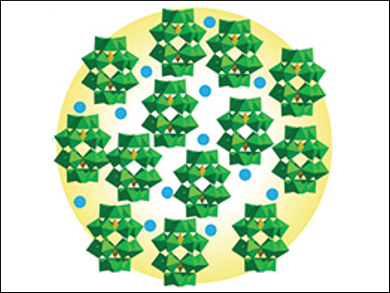Dye-sensitized solar cells (DSSCs) have attracted much attention as an alternative to traditional solar cells because of their simple fabrication process, low production costs, relatively high photoelectric conversion efficiency (PCE), and environmental safety. The dye-sensitized semiconductor photoanode plays a major part in the conversion efficiency of DSSCs because of its influence on the electron transport and the adsorption quantity of the dye.
Enbo Wang, Weilin Chen, Northeast Normal University, Changchun, China, and colleagues have investigated alternatives to the traditional TiO2 photoanode by creating hybrid materials using polyoxometalates (POMs). This class of compounds is comprised of large metal-oxide clusters and has previously been shown to act as electron mediators, which can improve the PCE of solar cells.
Hybrid photoanodes were made using TiO2, the Dawson POM anion, P2W18O626-, and either nickel or cobalt oxide. When assembled into solar cells and tested under simulated sunlight, the nickel composite displayed a PCE of 7.56 %, which is a 26 % increase over the traditional material. The researchers hope to extend their method to further POM systems for even better results.
- A Strategy for Breaking Polyoxometalate-based MOFs To Obtain High Loading Amounts of Nanosized Polyoxometalate Clusters to Improve the Performance of Dye-sensitized Solar Cells,
Xiaotao Zheng, Weilin Chen, Li Chen, Yijing Wang, Xiangwei Guo, Jiabo Wang, Enbo Wang,
Chem. Eur. J. 2017.
DOI: 10.1002/chem.201701103




